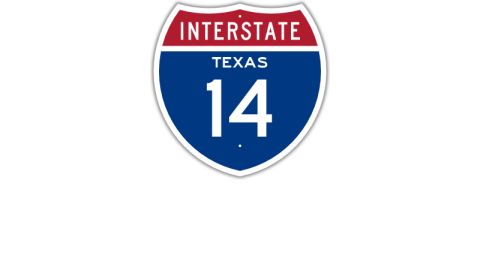

The next step has been taken to an Interstate highway passing through Brazos County.
President Obama’s signature on the transportation reauthorization bill includes Interstate 14.
The Washington lobbyist hired by the twin cities and the Research Valley Partnership to follow transportation issues, Larry Meyer, says Obama had supported the six year legislation.
Meyer says the first portion of I-14 has already been built, along Highway 190 from Fort Hood 35 miles to the east. The general alignment follows the path of 190 across the state.
Click below for comments from Larry Meyer, visiting with WTAW’s Bill Oliver:
News release from the Gulf Coast Strategic Highway Coalition:
The new five-year federal transportation bill signed into law December 4th creates a congressionally designated Texas highway corridor that will be Interstate Highway 14 in the future.
The designated Central Texas Corridor begins in West Texas and generally follows US Highway 190 through Killeen, Belton, Bryan-College Station, Huntsville, Livingston, Woodville and Jasper before terminating on State Highway 63 at the Sabine River.
The I-14 corridor designation amendment was sponsored in the U.S. Senate by Texas Senator John Cornyn. It was authored and presented in the U.S. House of Representatives by Texas Congressman Brian Babin of Woodville with support from Congressman Blake Farenthold of Corpus Christi, both members of the House Transportation Committee and Congressman Roger Williams who had served on the committee in the last congress.
“This major milestone in the improvement of transportation in Texas would not have been possible without the determined support of Senator Cornyn, Congressman Babin and Congressman Farenthold,” said John Thompson, chairman of the Gulf Coast Strategic Highway Coalition.
The Strategic Highway Coalition has been working for more than a decade in support of Texas highway improvements that will improve access between major U.S. Army installations at Fort Bliss, Fort Hood and Fort Polk and the Texas strategic deployment seaports that support them – the Port of Corpus Christi and the Port of Beaumont.
When asked about the new law, Senator Cornyn said, “Our highway transportation network in Texas plays a critical role in connecting military installations and communities, and I am pleased to have worked with members of the Texas delegation to add Interstate 14 and the Central Texas Corridor to the nation’s roadmap.”
Congressman Babin agreed, saying, “There is a reason this interstate already has a nickname, ‘Forts to Ports,’ as it provides either direct or very close access for some of our country’s most strategically important military and shipping assets. I was honored and proud to help lead this successful effort in designating the Central Texas Corridor as the first segment of what I truly believe will be America’s next great highway, Interstate 14.”
In helping introduce the amendment in the House, Congressman Roger Williams of Weatherford said that the I-14 route “is important for east-west connectivity and provides an important link to military facilities, metropolitan areas and Texas’ existing and future interstate system. This highway will connect two of the nation’s largest military bases, Fort Bliss and Fort Hood.” The I-14 designation will save travel time and create a key connector for freight movements while linking Army installations and strategic seaports, he said.
Jason Bienski, the mayor of Bryan cheered the new designation: “This is big for our future economic development. As the home of one of the world’s leading University Systems – Texas A&M and geographically located in the center of the Texas Triangle, we have sometimes been viewed as centrally isolated because we were not located on an Interstate Highway. Transportation continues to rank at the top of the list of site selection factors for employers. We can now check the Interstate box.”
The Mayor of College station, Nancy Berry agreed, “This is great news!” Both mayors had lobbied in Washington for the designation as a part of the Bryan College Station Chamber of Commerce annual trips to Washington.
A stretch of US 190 serving the Fort Hood-Killeen area and extending approximately 25 miles west from Interstate 35 at Belton to Copperas Cove is already at interstate highway standard. It will be renamed as I-14 and added to the national interstate highway system once a technical review is completed and the new designation is approved by the Federal Highway Administration, the American Association of Highway and Transportation Officials (AASHTO) and the Texas Transportation Commission. That process could be completed within the next year. Thompson stressed the future importance of a new interstate that will provide a safer, more efficient route across Central Texas while providing much needed connections between I-35 at Belton, I-45 at Huntsville and future I-69 at Livingston.
A feasibility study of upgrading the US 190 corridor prepared for the Texas Department of Transportation and completed in 2012 set the stage for designation of future Interstate 14 by Congress. It recognized the benefits of a high volume east-west highway that will serve a vast section of Texas between Interstate 20 and Interstate 10. “By creating a more efficient interstate highway system in the heart of Texas, Interstate 14 will allow the state to attract more economic development and jobs,” Thompson said.
Thompson anticipates that to the extent possible the future interstate will consist of upgrades to the existing US 190 roadway and that additional studies will be needed to determine specific local routing alternatives. US 190 improvements will take place incrementally over time as funding becomes available and traffic demand grows with the state’s population and freight traffic.
